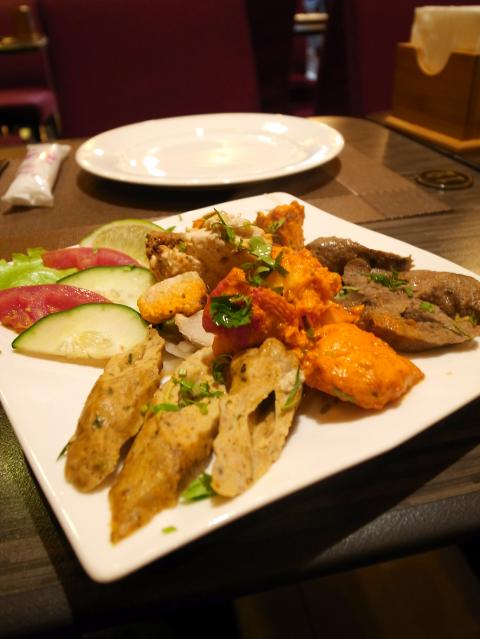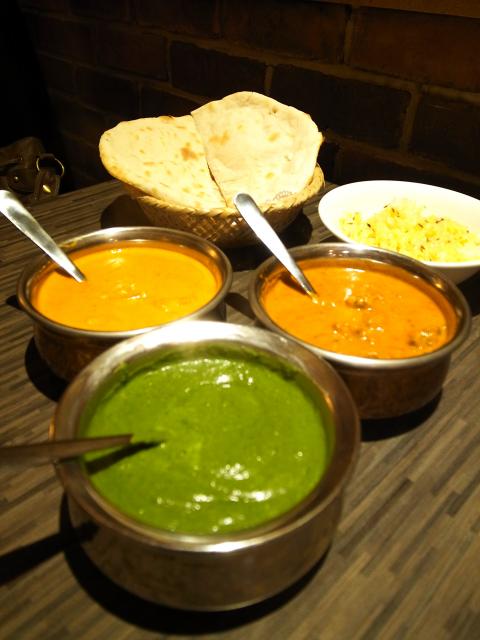Though located within walking distance of Taipei City Hall and the shopping quarter in the glossy Xinyi (信義) District, life on the side of perennially-jammed Keelung Road across from the World Trade Center has been dull, mostly revolving around a few undistinguished food stands, motorcycle repair shops and a convenience store. But things have spiced up a little since Mayur Indian Kitchen launched business over a year ago. And with the arrival of Khana Khazana Indian Restaurant last December, more flavors from the Indian subcontinent are sure to wow local foodies.
Unlike its neighbor Mayur, which is basically a kitchen counter with several tables lined up on the sidewalk, Khana Khazana boasts a spacious dining environment thankfully devoid of gaudy travel photos of South Asian landmarks. Despite its uninspiring entrance that suggests otherwise, the interior, tastefully painted in ocher red and decorated with India-themed paintings, feels relaxed and inviting.
Service is casual and friendly. The smiling young wait staff, though not satisfyingly knowledgeable about the rich south Asian fare, is able to provide suggestions to navigate through the restaurant’s extensive menu that covers north and south Indian cuisine and contains everything from raita salads (NT$120 to NT$180), pakoras (NT$160 to NT$260), rotis (NT$80 and NT$100), paranthas (NT$100 to NT$160) and biryanis (NT$380), to a wide selection of tandoori barbecues (NT$320 to NT$490) as well as keema (NT$320 to NT$360) and paneer dishes (NT$320).

Photo: Ho Yi, Taipei Times
Most of the Indian subcontinent’s better-known curry dishes are also present, ranging from masala, vindaloo, dopiaza and jalfrezi.
Following the recommendations made by our waiter, my friends and I began our feast with tomato soup (NT$90) and multani daal soup, or lentil soup with herbs (NT$90). Deceivingly simple and plain, the dishes wowed with an aromatic explosion of spices and herbs. Appetizer choices are plentiful, and the chana pindi (NT$220), or boiled chickpeas fried with tomatoes, potatoes, chili, ginger and masala, looked healthy and tasted good, but didn’t make a lasting impression.
For Indian barbecues, the tandoori mixed grill (NT$490) has chicken, lamb and fish all on one plate. Served with onions, cucumbers and plenty of lemon slices, the meat was properly charred but was a little bit too dry to my taste.

Photo: Ho Yi, Taipei Times
Moving on to the curry section, which comprises choices of chicken, lamb, fish, shrimp and vegetables. The first item that arrived was the Mughlai chicken (NT$370), which is said to be a famous dish from the Mughlai cuisine served at the imperial family’s dining table in north India. It was creamy, pleasantly mild and there was really nothing not to like about the tender tandoori chicken in cashew nuts sauce.
The chicken tikka jalfrezi (NT$370), another north Indian dish, features boneless tandoori chicken first roasted, then fried with onions and red and green peppers in capsicum curry sauce. It was good and mildly spicy, but all curry dishes can be made more pungent based on customer request.
South Indian in character, lamb tikka masala (NT$360) is made up of tandoori lamb tossed in coconut sauce and makes another smooth and creamy curry delicacy.
Among the restaurant’s array of vegetable dishes, we had the sag paneer (NT$260), which is made with homemade paneer, or Indian cottage cheese, cooked with freshly pureed spinach, ginger and spices. The paneer lent the curry a luscious zest and made it my favorite dish of the night.
Other vegetarian options that come highly recommended include aloo gobhi (NT$280), or cauliflower and potatoes cooked with herbs and spices, and mixed vegetable jalfrezi (NT$300).
For an extra NT$60, diners can have naan and a bowl of pilau rice sprinkled with plenty of cumin seeds to go with main courses. Khana Khazana’s rendition of the Indian flatbread is moist and chewy and comes in seven savory or sweet flavors (NT$40 to NT$120).
For dessert, the restaurant offers homemade cashew nuts-flavored kulfi, or Indian ice cream (NT$120 for two scoops), among the usual gulab jamun (deep-fried milk balls served in sugar syrup, NT$120). Lassi (NT$90 to NT$140) is remarkably yummy and comes in five flavors ranging from salted, mango to peach.
I ended my meal with Indian masala tea (NT$80, NT$120 cold), a great drink to have during cold winter days when it is served steaming hot with cinnamon, cloves and ginger.
According to our waiter, the team that manages Khana Khazana Indian Restaurant comes from the beloved Bollywood Indian Restaurant (魔力屋) in Taichung City. Judging from the quality food it serves, the north spin-off may soon become as popular as its counterpart in central Taiwan.

April 28 to May 4 During the Japanese colonial era, a city’s “first” high school typically served Japanese students, while Taiwanese attended the “second” high school. Only in Taichung was this reversed. That’s because when Taichung First High School opened its doors on May 1, 1915 to serve Taiwanese students who were previously barred from secondary education, it was the only high school in town. Former principal Hideo Azukisawa threatened to quit when the government in 1922 attempted to transfer the “first” designation to a new local high school for Japanese students, leading to this unusual situation. Prior to the Taichung First

The Ministry of Education last month proposed a nationwide ban on mobile devices in schools, aiming to curb concerns over student phone addiction. Under the revised regulation, which will take effect in August, teachers and schools will be required to collect mobile devices — including phones, laptops and wearables devices — for safekeeping during school hours, unless they are being used for educational purposes. For Chang Fong-ching (張鳳琴), the ban will have a positive impact. “It’s a good move,” says the professor in the department of

On April 17, Chinese Nationalist Party (KMT) Chairman Eric Chu (朱立倫) launched a bold campaign to revive and revitalize the KMT base by calling for an impromptu rally at the Taipei prosecutor’s offices to protest recent arrests of KMT recall campaigners over allegations of forgery and fraud involving signatures of dead voters. The protest had no time to apply for permits and was illegal, but that played into the sense of opposition grievance at alleged weaponization of the judiciary by the Democratic Progressive Party (DPP) to “annihilate” the opposition parties. Blamed for faltering recall campaigns and faced with a KMT chair

Article 2 of the Additional Articles of the Constitution of the Republic of China (中華民國憲法增修條文) stipulates that upon a vote of no confidence in the premier, the president can dissolve the legislature within 10 days. If the legislature is dissolved, a new legislative election must be held within 60 days, and the legislators’ terms will then be reckoned from that election. Two weeks ago Taipei Mayor Chiang Wan-an (蔣萬安) of the Chinese Nationalist Party (KMT) proposed that the legislature hold a vote of no confidence in the premier and dare the president to dissolve the legislature. The legislature is currently controlled